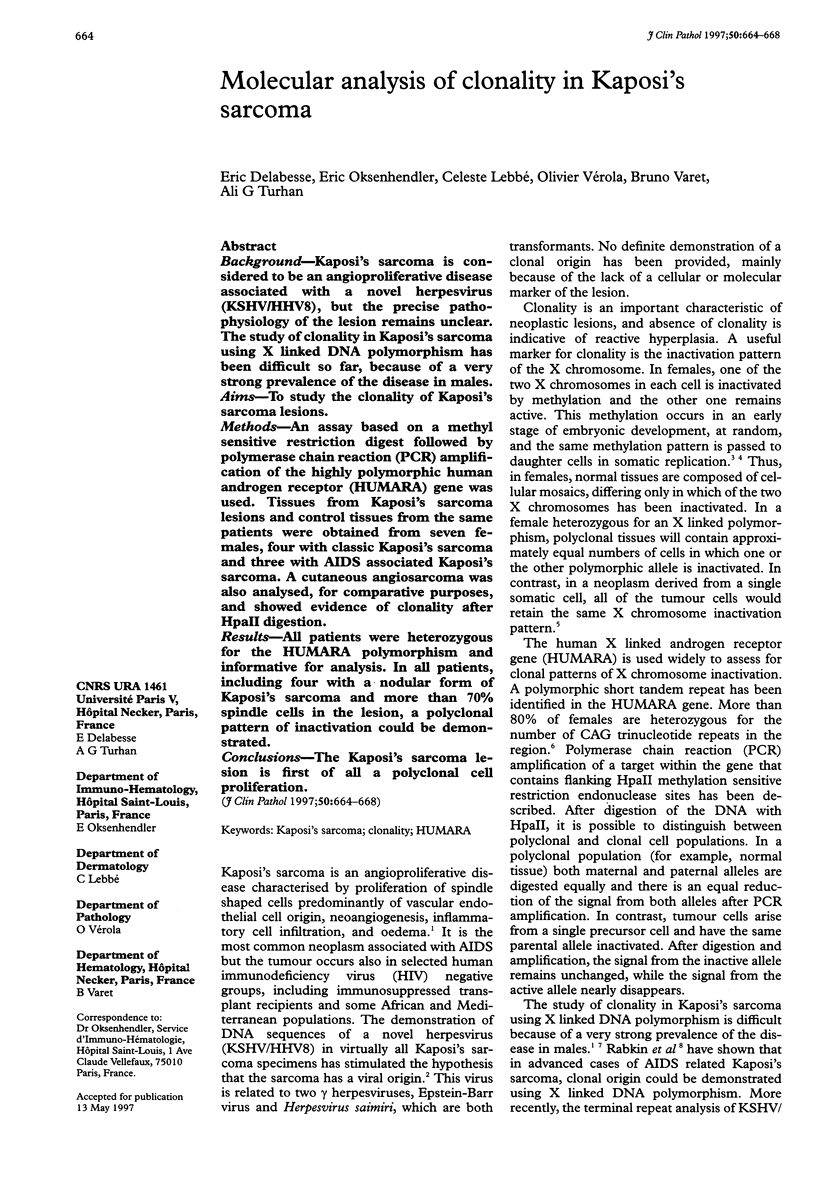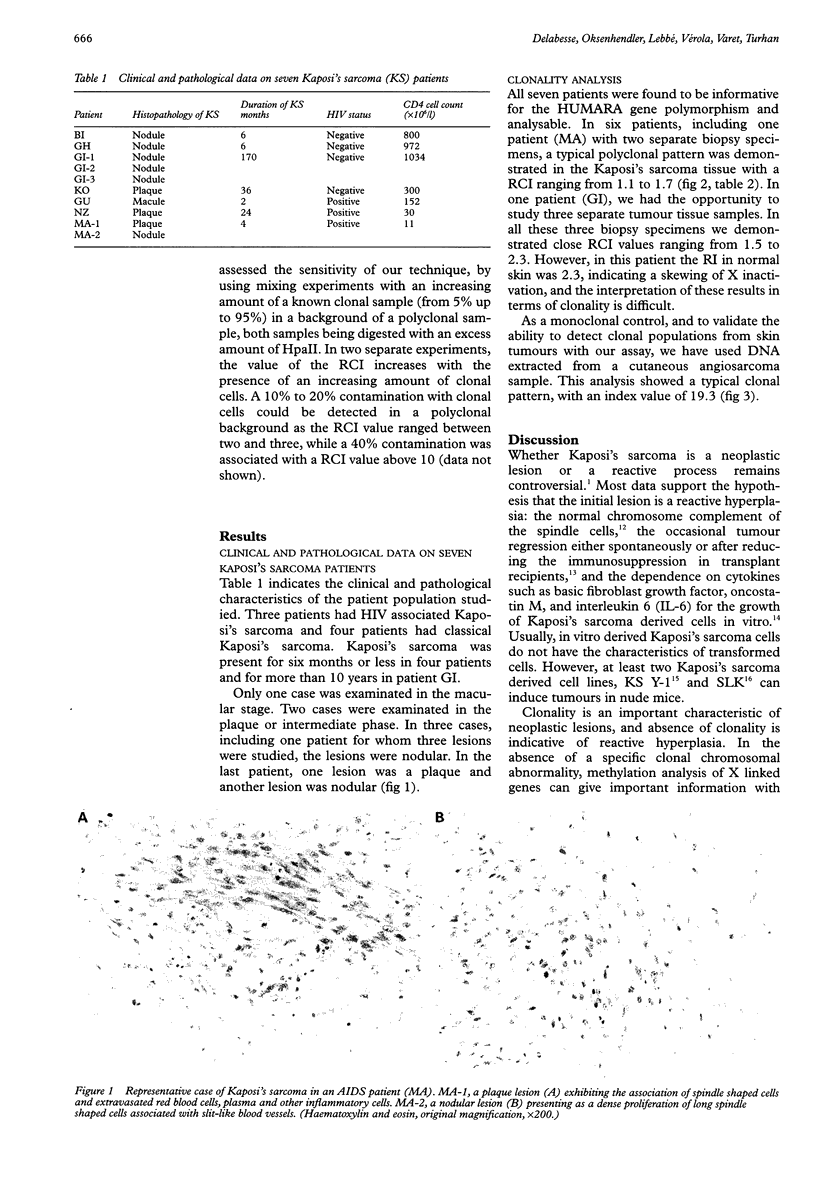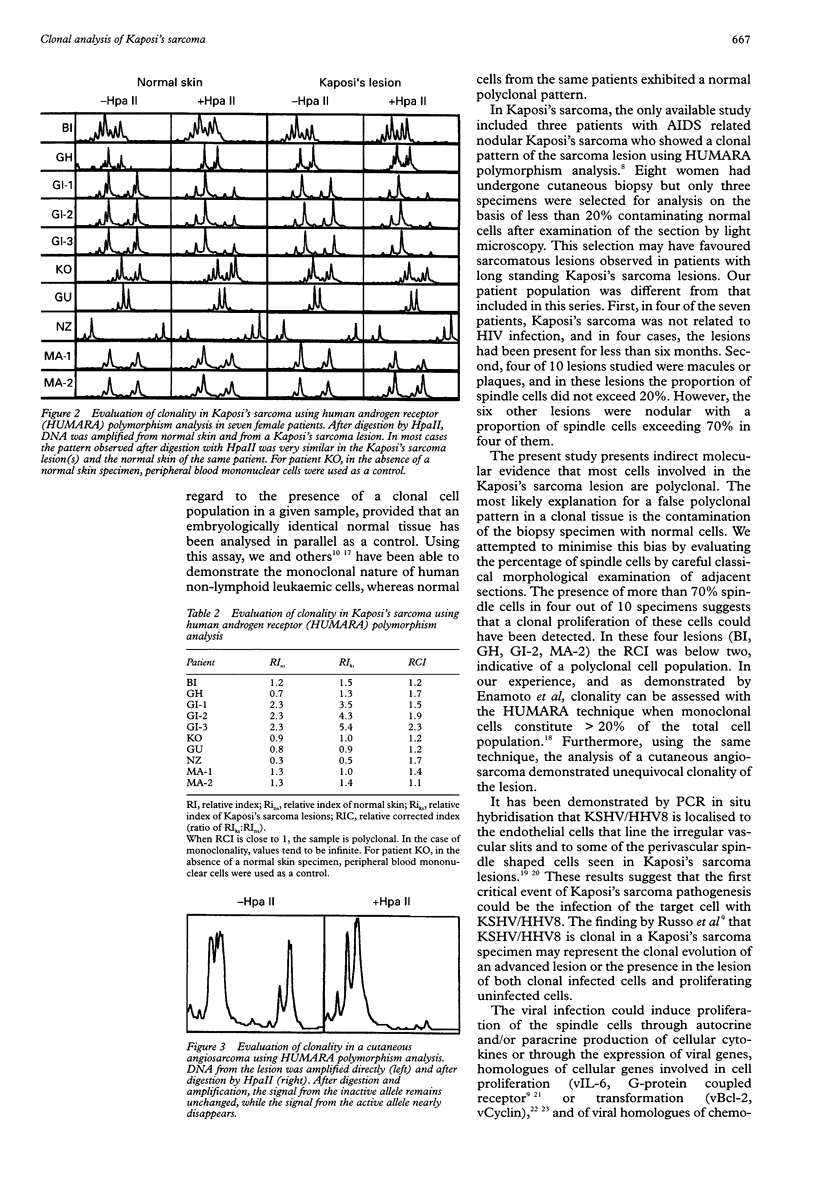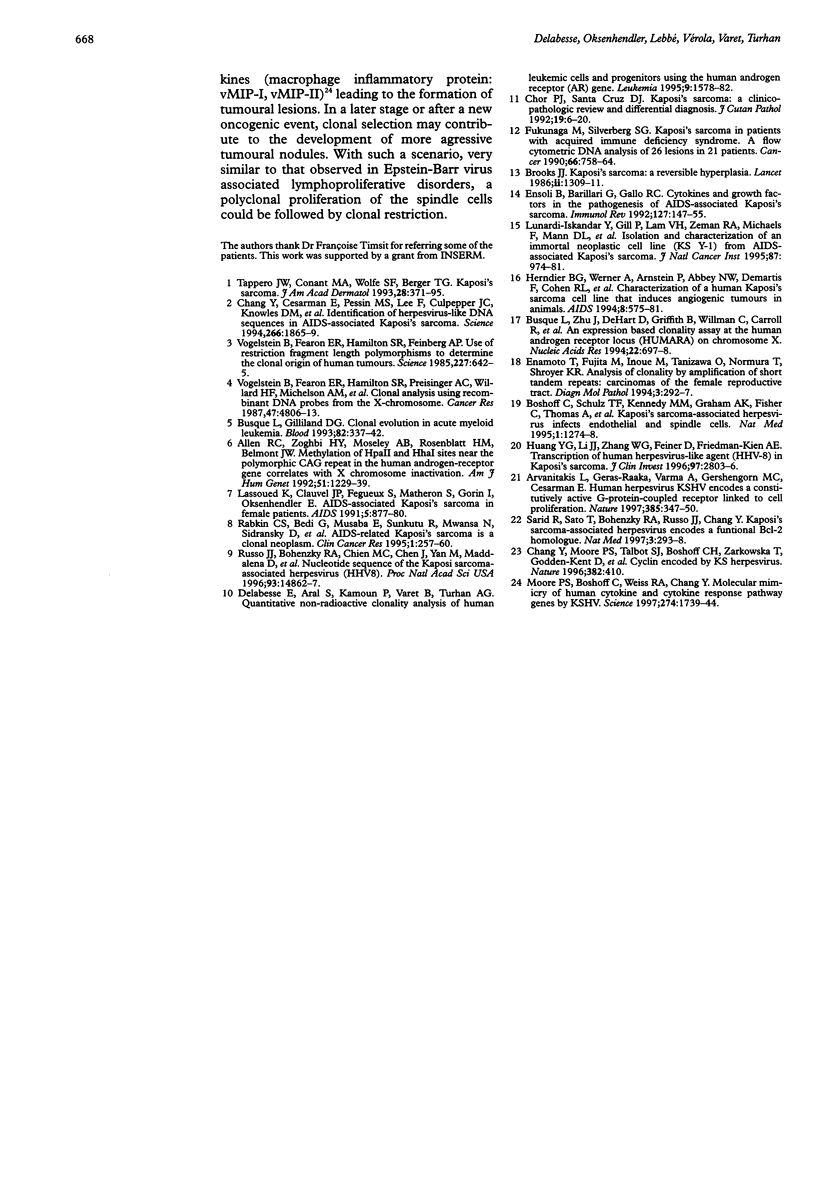Abstract
BACKGROUND: Kaposi's sarcoma is considered to be an angioproliferative disease associated with a novel herpesvirus (KSHV/HHV8), but the precise pathophysiology of the lesion remains unclear. The study of clonality in Kaposi's sarcoma using X linked DNA polymorphism has been difficult so far, because of a very strong prevalence of the disease in males. AIMS: To study the clonality of Kaposi's sarcoma lesions. METHODS: An assay based on a methyl sensitive restriction digest followed by polymerase chain reaction (PCR) amplification of the highly polymorphic human androgen receptor (HUMARA) gene was used. Tissues from Kaposi's sarcoma lesions and control tissues from the same patients were obtained from seven females, four with classic Kaposi's sarcoma and three with AIDS associated Kaposi's sarcoma. A cutaneous angiosarcoma was also analysed, for comparative purposes, and showed evidence of clonality after HpaII digestion. RESULTS: All patients were heterozygous for the HUMARA polymorphism and informative for analysis. In all patients, including four with a nodular form of Kaposi's sarcoma and more than 70% spindle cells in the lesion, a polyclonal pattern of inactivation could be demonstrated. CONCLUSIONS: The Kaposi's sarcoma lesion is first of all a polyclonal cell proliferation.
Full text
PDF




Images in this article
Selected References
These references are in PubMed. This may not be the complete list of references from this article.
- Allen R. C., Zoghbi H. Y., Moseley A. B., Rosenblatt H. M., Belmont J. W. Methylation of HpaII and HhaI sites near the polymorphic CAG repeat in the human androgen-receptor gene correlates with X chromosome inactivation. Am J Hum Genet. 1992 Dec;51(6):1229–1239. [PMC free article] [PubMed] [Google Scholar]
- Arvanitakis L., Geras-Raaka E., Varma A., Gershengorn M. C., Cesarman E. Human herpesvirus KSHV encodes a constitutively active G-protein-coupled receptor linked to cell proliferation. Nature. 1997 Jan 23;385(6614):347–350. doi: 10.1038/385347a0. [DOI] [PubMed] [Google Scholar]
- Boshoff C., Schulz T. F., Kennedy M. M., Graham A. K., Fisher C., Thomas A., McGee J. O., Weiss R. A., O'Leary J. J. Kaposi's sarcoma-associated herpesvirus infects endothelial and spindle cells. Nat Med. 1995 Dec;1(12):1274–1278. doi: 10.1038/nm1295-1274. [DOI] [PubMed] [Google Scholar]
- Brooks J. J. Kaposi's sarcoma: a reversible hyperplasia. Lancet. 1986 Dec 6;2(8519):1309–1311. doi: 10.1016/s0140-6736(86)91436-4. [DOI] [PubMed] [Google Scholar]
- Busque L., Gilliland D. G. Clonal evolution in acute myeloid leukemia. Blood. 1993 Jul 15;82(2):337–342. [PubMed] [Google Scholar]
- Busque L., Zhu J., DeHart D., Griffith B., Willman C., Carroll R., Black P. M., Gilliland D. G. An expression based clonality assay at the human androgen receptor locus (HUMARA) on chromosome X. Nucleic Acids Res. 1994 Feb 25;22(4):697–698. doi: 10.1093/nar/22.4.697. [DOI] [PMC free article] [PubMed] [Google Scholar]
- Chang Y., Cesarman E., Pessin M. S., Lee F., Culpepper J., Knowles D. M., Moore P. S. Identification of herpesvirus-like DNA sequences in AIDS-associated Kaposi's sarcoma. Science. 1994 Dec 16;266(5192):1865–1869. doi: 10.1126/science.7997879. [DOI] [PubMed] [Google Scholar]
- Chang Y., Moore P. S., Talbot S. J., Boshoff C. H., Zarkowska T., Godden-Kent, Paterson H., Weiss R. A., Mittnacht S. Cyclin encoded by KS herpesvirus. Nature. 1996 Aug 1;382(6590):410–410. doi: 10.1038/382410a0. [DOI] [PubMed] [Google Scholar]
- Chor P. J., Santa Cruz D. J. Kaposi's sarcoma. A clinicopathologic review and differential diagnosis. J Cutan Pathol. 1992 Feb;19(1):6–20. doi: 10.1111/j.1600-0560.1992.tb01553.x. [DOI] [PubMed] [Google Scholar]
- Delabesse E., Aral S., Kamoun P., Varet B., Turhan A. G. Quantitative non-radioactive clonality analysis of human leukemic cells and progenitors using the human androgen receptor (AR) gene. Leukemia. 1995 Sep;9(9):1578–1582. [PubMed] [Google Scholar]
- Enomoto T., Fujita M., Inoue M., Tanizawa O., Nomura T., Shroyer K. R. Analysis of clonality by amplification of short tandem repeats. Carcinomas of the female reproductive tract. Diagn Mol Pathol. 1994 Dec;3(4):292–297. doi: 10.1097/00019606-199412000-00013. [DOI] [PubMed] [Google Scholar]
- Ensoli B., Barillari G., Gallo R. C. Cytokines and growth factors in the pathogenesis of AIDS-associated Kaposi's sarcoma. Immunol Rev. 1992 Jun;127:147–155. doi: 10.1111/j.1600-065x.1992.tb01412.x. [DOI] [PubMed] [Google Scholar]
- Fukunaga M., Silverberg S. G. Kaposi's sarcoma in patients with acquired immune deficiency syndrome. A flow cytometric DNA analysis of 26 lesions in 21 patients. Cancer. 1990 Aug 15;66(4):758–764. doi: 10.1002/1097-0142(19900815)66:4<758::aid-cncr2820660427>3.0.co;2-h. [DOI] [PubMed] [Google Scholar]
- Herndier B. G., Werner A., Arnstein P., Abbey N. W., Demartis F., Cohen R. L., Shuman M. A., Levy J. A. Characterization of a human Kaposi's sarcoma cell line that induces angiogenic tumors in animals. AIDS. 1994 May;8(5):575–581. doi: 10.1097/00002030-199405000-00002. [DOI] [PubMed] [Google Scholar]
- Huang Y. Q., Li J. J., Zhang W. G., Feiner D., Friedman-Kien A. E. Transcription of human herpesvirus-like agent (HHV-8) in Kaposi's sarcoma. J Clin Invest. 1996 Jun 15;97(12):2803–2806. doi: 10.1172/JCI118735. [DOI] [PMC free article] [PubMed] [Google Scholar]
- Lassoued K., Clauvel J. P., Fegueux S., Matheron S., Gorin I., Oksenhendler E. AIDS-associated Kaposi's sarcoma in female patients. AIDS. 1991 Jul;5(7):877–880. doi: 10.1097/00002030-199107000-00013. [DOI] [PubMed] [Google Scholar]
- Lunardi-Iskandar Y., Gill P., Lam V. H., Zeman R. A., Michaels F., Mann D. L., Reitz M. S., Jr, Kaplan M., Berneman Z. N., Carter D. Isolation and characterization of an immortal neoplastic cell line (KS Y-1) from AIDS-associated Kaposi's sarcoma. J Natl Cancer Inst. 1995 Jul 5;87(13):974–981. doi: 10.1093/jnci/87.13.974. [DOI] [PubMed] [Google Scholar]
- Moore P. S., Boshoff C., Weiss R. A., Chang Y. Molecular mimicry of human cytokine and cytokine response pathway genes by KSHV. Science. 1996 Dec 6;274(5293):1739–1744. doi: 10.1126/science.274.5293.1739. [DOI] [PubMed] [Google Scholar]
- Rabkin C. S., Bedi G., Musaba E., Sunkutu R., Mwansa N., Sidransky D., Biggar R. J. AIDS-related Kaposi's sarcoma is a clonal neoplasm. Clin Cancer Res. 1995 Mar;1(3):257–260. [PubMed] [Google Scholar]
- Russo J. J., Bohenzky R. A., Chien M. C., Chen J., Yan M., Maddalena D., Parry J. P., Peruzzi D., Edelman I. S., Chang Y. Nucleotide sequence of the Kaposi sarcoma-associated herpesvirus (HHV8). Proc Natl Acad Sci U S A. 1996 Dec 10;93(25):14862–14867. doi: 10.1073/pnas.93.25.14862. [DOI] [PMC free article] [PubMed] [Google Scholar]
- Sarid R., Sato T., Bohenzky R. A., Russo J. J., Chang Y. Kaposi's sarcoma-associated herpesvirus encodes a functional bcl-2 homologue. Nat Med. 1997 Mar;3(3):293–298. doi: 10.1038/nm0397-293. [DOI] [PubMed] [Google Scholar]
- Tappero J. W., Conant M. A., Wolfe S. F., Berger T. G. Kaposi's sarcoma. Epidemiology, pathogenesis, histology, clinical spectrum, staging criteria and therapy. J Am Acad Dermatol. 1993 Mar;28(3):371–395. doi: 10.1016/0190-9622(93)70057-z. [DOI] [PubMed] [Google Scholar]
- Vogelstein B., Fearon E. R., Hamilton S. R., Feinberg A. P. Use of restriction fragment length polymorphisms to determine the clonal origin of human tumors. Science. 1985 Feb 8;227(4687):642–645. doi: 10.1126/science.2982210. [DOI] [PubMed] [Google Scholar]
- Vogelstein B., Fearon E. R., Hamilton S. R., Preisinger A. C., Willard H. F., Michelson A. M., Riggs A. D., Orkin S. H. Clonal analysis using recombinant DNA probes from the X-chromosome. Cancer Res. 1987 Sep 15;47(18):4806–4813. [PubMed] [Google Scholar]



